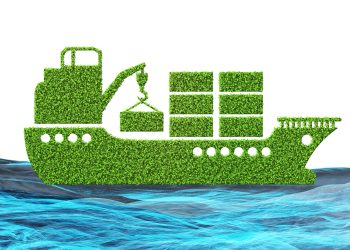Emissions-reduction system could save 15 billion annually by 2030
The Commission said in a statement it would outline “a simple, robust and globally feasible approach towards setting a system for monitoring, reporting and verification of emissions based on fuel consumption”.
This was “the necessary starting point” for further action on greenhouse gas emissions, it said, flagging market-based mechanisms.
These could include a maritime emissions trading scheme (ETS) or bunker fuel levies.
Elina Bardram, the head of the EU climate department’s international carbon markets unit, said that setting up a market-based emissions-reduction system could save 15 billion annually by 2030, and increase employment in the sector.
“We can set this up more quickly than for aviation,” she told a European Policy Centre conference on 18 September.
But there is intense opposition to such a move from other departments in the European Commission which are unhappy about the ongoing trade spat with China over bringing aviation emissions into the ETS.
‘Too difficult, too politically charged’
Introducing a similar market-based mechanismfor shipping emissions would be “too difficult, too politically charged”, one senior official in the EU’s transport directorate told EurActiv last year.
“We need to keep [any scheme] IMO-related,” the source said, referring to the International Maritime Organization.
The “monitoring, reporting and verification system,” or MRV, announced jointly yesterday by Transport Commissioner Siim Kallas and Climate Action Commissioner Connie Hedegaard stopped shy of announcing new market-based mechanisms.
It also stressed the need to work with the IMO towards a global deal, and was made with one eye on the start of a week-long IMO conference this week in London, according to EU sources.
“It does feed into their process so it makes sense”, one EU official told EurActiv.
“We just realised that what everyone needs is MRV and that will feed into what the IMO is doing,” the official said, adding that for the second step – the market-based mechanisms that the EU will propose – “you’ll have to stay tuned.”
MBM timing
The timing of any forthcoming market-based measures may depend in part on the experience of the MRV proposal, and any emissions reducing proposals put forward by the IMO.
The EU statement praised the shipping group for its decision last year to impose energy efficiency measures.
The IMO’s Energy Efficiency Design Index will only come into force in 2015. But Hedegaard and Kallas warned that the index alone “will not be enough to ensure shipping emissions are reduced fast enough” to meet the EU’s 2020 targets.
An IMO report itself said that the indexmeasures would only cut emissions by about 23% and that the sector’s greenhouse gas levels could rise without further market-based measures.
“The shipping industry itself is best placed to take the lead in delivering fast and effective greenhouse gas emission reductions”, the EU statement said, adding “the Commission is ready to play its part, in the EU and at IMO level.
Positions
Green pressure groupsTransport and Environment andSeas at Risk said in a joint statement that they were “disappointed” at what they viewed as a “new postponement to cut shipping emissions”.
T&E’s shipping programme manager, Bill Hemmings, and a policy advisor at Seas at Risk, John Maggs, said: “green groups are disappointed because emissions monitoring doesn’t address the main issue at stake: reducing GHG emissions from ships”.
The statement said: “The EU has thus far not taken any measures to tackle GHGs from the shipping sector, and progress within the International Maritime Organisation on a global market-based measure has stalled amid arguments over technology transfer and global climate change policy.”
The environment groups said there was enormous potential in shipping to improve fuel efficiency in shipping, claiming that at least a 20% reduction in emissions would be “cost-free”, but that industry barriers were preventing action.
They also called on the Commission to monitor pollutants other than just carbon dioxide, including sulphur oxide and nitrogen oxide, and the need to impose stricter verification standards for such pollutants over 2015-2016.
Next steps
- Early 2013: Monitoring, reporting and verification system (MRV)expected to enter into force.
- 2015: Energy Efficiency Design Index (EEDI)enters into force along with possible market-based measures.
Source: Euractiv.com




























































